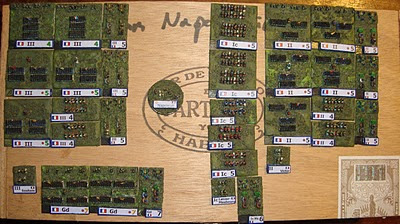A Napoleonic Volley & Bayonet Battle in 1/900 Scale.
In order to try out my new battleboards, I decided to put together a small (+/- 3000 points per side) battle using the new second edition of the Volley & Bayonet rules.
My 2mm armies are not completely formated for V&B 2nd Ed. yet, but I have a lot of them and, with a bit of hedging, I can use them with the new rules.
This battle was a "roll your own" affair using the campaign system represented in the book. It takes place somewhere in northern Austria in 1813. Napoleon at the head of two infantry and one cavalry corps and backed up by a division of Middle Guards runs smack into two Austrian infantry corps and assorted support units.
The two armies are pictured below. Note that in my V&B set-up, I don't use divisional commanders as these are faily useless , in my oppinion, and just clutter up the table. Seeing as how they are simply a marker notating a division's center of gravity and can be placed wherever a player likes, every turn, I simply point to a spot and say "the commander's here", drawing command from that point.
The French Army

II Corps, Victor
5 4-5 Infantry brigades, 1 2-5 Light Cavalry Brigade, 3 2-5 Artillery battalions
All infantry brigades have an extra skirmisher attached (so they are effectively 5-5), Basically, on legere regiment was broken down in each corp to give all the non-legere regiments a skirmisher.
III Corps, Souham3 4-5 Infantry brigades, 2 4-4 Infantry brigades, 1 2-5 Light Cavalry Brigade, 3 2-5 Artillery battalions
All infantry brigades have an extra skirmisher attached and all infantry are poorly trained. The two 4-4 brigades have no elites (they are effectively 5-4 with their attached skirmishers).
I Cavalry Corps, Latour-Mauborg
2 2-5 Dragoon Brigades, 1 3-5 Light Cavalry Brigade, 1 1-6 Horse Artillery Battery.
Reserve, Napoleon
2 5-7 Guards Brigades, 1 2-7 Artillery Battalion.
The Guards brigaes have inherent infantry skirmishers. Napoleon, of course, is also the army commander and a monarch (which means some special rules apply to him).
The Austrian Army
 I Corps, Colloredo
I Corps, Colloredo
8 6-4 Infantry Regiments, 1 3-4 Grenz Regiment, 1 3-5 Light Cavalry Brigade, 1 1-6 Horse Artillery battery, 1 3-6 Field Artillery Brigade.
All Infantry and Grenz Regiments have brigade guns and no elites. The Grenz regiment can break down and skirmish, but since I have no skirmish stands done for the Austrians yet, they're pretty much SOL.
II Corps, Meerveldt
8 6-4 Infantry Regiments, 1 3-4 Grenz Regiment, 1 2-5 Light Cavalry Brigade, 1 1-6 Horse Artillery battery, 1 3-6 Field Artillery Brigade.
All Infantry and Grenz Regiments have brigade guns and no elites. The Grenz regiment can break down and skirmish.
Reserve Corps, Nostitz
3 2-6 Heavy Cavalry Brigades, 1 1-6 Horse Artillery Battery, 2 3-4 Grenz Regiments, 1 2-5 Light Cavalry Brigade.
All Grenz Regiments have brigade guns and no elites.
 The battlefield, divided into set-up areas.
The battlefield, divided into set-up areas.
The French line of communications leads off of the road in the upper right corner of the map. Austrian communications lead off board from the road in the lower left corner. Note that neither player has seen the map before organizing their armies into three sections and a reserve,. They thus cannot optimize their wings according to the terrain.
The French Army is organized as follows:
Right Wing
2 4-4 brigades, 1 4-5 brigade, 2 artillery. Souham.
Left Wing
3 4-5 brigades, 2 artillery and all cavalry from II and III Corps. Victor.
Center
2 4-5 brigades, 1 artillery from III Corps. 2 4-5 brigades, 1 artillery from II Corps. 1 Light Cavalry Brigade from I Cavalry Corps. Latour-Mauborg.
Reserve
2 Guards brigades, 1 Guards artillery, 2 Dragoon brigades, 1 Horse artillery battalion. Napoleon.
The Austrian army is organized as follows:
Right Wing
4 Infantry regiments, 1 grenz regiment, 1 horse artillery, 1 light cavalry brigade from I Corps. Coloredo.
Left Wing
4 Infantry regiments, 1 grenz regiment, 1 horse artillery, 1 light cavalry brigade from I Corps.
Meerveldt.
Center
4 Infantry regiments, 1 artillery battalion from I corps; 4 Infantry regiments, 1 artillery battalion from I corps.
Reserve
The Reserve Corps. Meerveldt.
